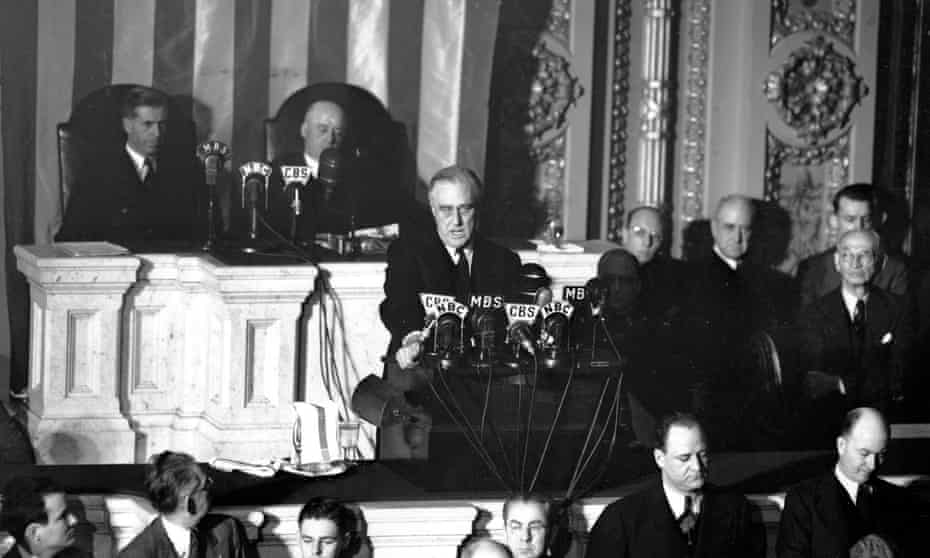Think big on climate: the transformation of society in months has been done before

The astonishing story of how the US entered the second world war should be on everyone’s minds as Cop26 approaches

Fatalism creeps across our movements like rust. In conversations with scientists and activists, I hear the same words, over and again: “We’re screwed.” Government plans are too little, too late. They are unlikely to prevent the Earth’s systems from flipping into new states hostile to humans and many other species.
What we need, to stand a high chance of stabilising our life support systems, is not slow and incremental change but sudden and drastic action. And this is widely considered impossible. There’s no money; governments are powerless; people won’t tolerate anything more ambitious than the tepid measures they have proposed. Or so we are told. It’s a stark illustration of a general rule: political failure is, at heart, a failure of imagination.
Let’s set aside the obvious lessons of the pandemic, when the magic money tree miraculously burst into leaf, governments discovered they could govern (albeit with varying degrees of competence) and people were prepared radically to change their behaviour. There’s a bigger and more powerful example. It’s what happened when the US joined the second world war.
There’s discomfort in environmental circles with military analogies. But the war is among the few precedents and metaphors that almost everyone can grasp. And we would be foolish not to learn from this remarkable lesson.
Before the US declared war, President Franklin Roosevelt had begun to draft troops and build his “arsenal of democracy”: the materiel with which he supplied the allied forces. To “outbuild Hitler”, he called for levels of production widely considered impossible. But after the Japanese attack on Pearl Harbor on 7 December 1941, the impossible happened.
The day after the attack, Roosevelt requested and achieved a declaration of war from Congress. He immediately began to reorganise not only the government but the entire nation. He set up a series of agencies that were lightly overseen but coordinated through simple but effective measures such as the “controlled materials plan”.
He introduced, for the first time in US history, general federal income taxes. The government rapidly raised the top rate until, in 1944, it reached 94%. It issued war bonds and borrowed massively. Between 1940 and 1945, total government spending rose roughly tenfold. Astonishingly the US government spent more money (in current dollar terms) between 1942 and 1945 than it had between 1789 and 1941. From 1940 to 1944, its military budget rose by a factor of 42, outstripping Germany’s, Japan’s and the United Kingdom’s put together.
Civilian industries were entirely retooled for war. When the car industry was instructed to switch to military production, its massive equipment was immediately jack-hammered out of the floor and replaced, often in a matter of weeks, with new machines. General Motors began turning out tanks, aircraft engines, fighter planes, cannons and machine guns. Oldsmobile started making artillery shells; Pontiac produced anti-aircraft guns. By 1944, Ford was completing a long-range bomber plane almost every hour. During its three years of war, the US manufactured 87,000 naval vessels, including 27 aircraft carriers, 300,000 planes, 100,000 tanks and armoured cars and 44bn rounds of ammunition. Roosevelt described it as a “miracle of production”. But it wasn’t a miracle. It was the realisation of a well-laid plan.
The US war effort mobilised tens of millions of people. Between 1940 and the end of the war, the number of American troops rose 26-fold, while the civilian labour force increased by 10 million. Many of the new workers were women.
From 1942 until 1945, the manufacture of cars was banned. So were new household appliances and even the construction of new homes. Tyres and gasoline were strictly rationed; meat, butter, sugar, clothes and shoes were also limited. Rationing was considered fairer than taxing scarce goods: it ensured everyone received an equal share. A national speed limit of 35mph was imposed, to save fuel.
Posters warned people “When you ride ALONE, you ride with Hitler! Join a car-sharing club TODAY”, and asked “Is this trip really necessary?”. They cautioned: “Waste helps the enemy: conserve material”. Americans were urged to sign the Consumer’s Victory Pledge: “I will buy carefully; I will take good care of the things I have; I will waste nothing.” Every imaginable material – chewing gum wrappers, rubber bands, used cooking fat – was recycled.
So what stops the world from responding with the same decisive force to the greatest crisis humanity has ever faced? It’s not a lack of money or capacity or technology. If anything, digitisation would make such a transformation quicker and easier. It’s a problem that Roosevelt faced until Pearl Harbor: a lack of political will. Now, just as then, public hostility and indifference, encouraged by legacy industries (today, above all, fossil fuel, transport, infrastructure, meat and media), outweighs the demand for intervention.
The difference between 1941 and 2021 is that now the mobilisation needs to come first. We need to build popular movements so big that governments have no choice but to respond to them, if they wish to remain in office. We need to make politicians understand that the survival of life on Earth is more important than their ideological commitment to limited government. Preventing Earth’s systems from flipping means flipping our political systems.
So what is our Pearl Harbor moment? Well, how about now? After all, to extend the analogy, the Pacific seaboard of the US has recently come under unprecedented climatic attack. The heat domes, the droughts and fires there this year should have been enough to shock everyone out of their isolationism. But the gap between these events and people’s understanding of the forces that caused them is, arguably, the greatest public information failure in human history. We need bodies equivalent to Roosevelt’s Office of War Information, constantly reminding people of what is at stake.
As the US mobilisation showed, when governments and societies decide to be competent, they can achieve things that at other times are considered impossible. Catastrophe is not a matter of fate. It’s a matter of choice.